
Midtown Madness is a 1999 racing game developed by Angel Studios and published by Microsoft for Microsoft Windows. The demo version was released in April 1999. Two sequels followed, with Midtown Madness 2 released in September 2000 and Midtown Madness 3 released in June 2003 for the Xbox. The game is set in Chicago; the object is for the player to win street races and obtain new cars.

Need for Speed: Underground is a 2003 racing video game and the seventh installment in the Need for Speed series. It was developed by EA Black Box and published by Electronic Arts. Three different versions of the game were produced: one for consoles and Microsoft Windows, and another for the Game Boy Advance. An arcade version was additionally developed by Global VR, and was published by Konami with assistance from Electronic Arts.

4x4 Evo is a video game developed by Terminal Reality for the Windows, Macintosh, Sega Dreamcast, and PlayStation 2 platforms. It is one of the first console games to have cross-platform online play where Dreamcast, Macintosh, and Windows versions of the game appear online at the same time. The game can use maps created by users to download onto a hard drive as well as a Dreamcast VMU. All versions of the game are similar in quality and gameplay although the online systems feature a mode to customize the players' own truck and use it online. The game is still online-capable on all systems except for PlayStation 2. This was Terminal Reality's only video game to be released for the Dreamcast.

Need for Speed: High Stakes is a 1999 racing video game developed by EA Canada and EA Seattle and published by Electronic Arts for the PlayStation and Microsoft Windows. It is the fourth game in the Need for Speed series and a follow-up to Need for Speed III: Hot Pursuit. The game features more realistic elements than its predecessors and introduced a damage system that allows cars to take damage when colliding with objects, affecting their appearance and performance. It also introduced a series of economy-based tournaments, awarding players with a cash prize that can be spent on repairing, purchasing, or upgrading cars for subsequent races. The game's Hot Pursuit mode, which was introduced in Hot Pursuit, was expanded with more options, allowing players to control police pursuits attempting to stop racers.

Need for Speed: Porsche Unleashed, released as Need for Speed: Porsche 2000 in Europe and Need for Speed: Porsche in Latin America and Germany, is a racing video game released in 2000. It is the fifth installment in the Need for Speed series. Unlike other NFS titles, Porsche Unleashed centers on racing Porsche sports cars, with models ranging from years 1950 to 2000.
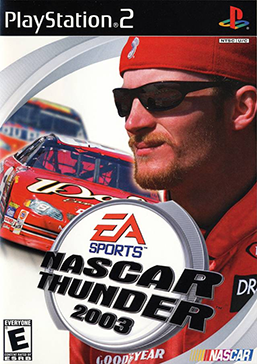
NASCAR Thunder 2003 is the sixth edition of the EA Sports' NASCAR racing simulator series. Developed by EA Sports and Budcat Creations and published by Electronic Arts. It was released for PlayStation, PlayStation 2, GameCube, and Xbox on September 19, 2002, and for Microsoft Windows on October 16. The product features Dale Earnhardt Jr. on the cover. It was the first time the NASCAR's Most Popular Driver Award recipient was featured on the cover, although he did not win the award for the first time until the following year. Dale Earnhardt appeared in the game as a driver as a result of entering his name as a Create-A-Car driver's name; he did not appear in the previous game due to his death. He appeared as a legend in subsequent games.

Lego Racers is a Lego-themed racing video game developed by High Voltage Software and published by Lego Media in 1999.

TOCA: Touring Car Championship is a 3D racing video game licensed by series organisers TOCA, and developed and published by Codemasters for the PlayStation and Microsoft Windows platforms in 1997-1998. It was re-released by Codemasters for the Game Boy Color in 2000. It was the first entry in the eponymous series and was followed by TOCA 2 Touring Cars in 1998. The player takes control of a driver who races for one of the eight works teams that contested the 1997 British Touring Car Championship against fifteen AI competitors on one of the nine championship circuits. A championship mode is available for players with the objective of earning points to continue competing and unlocking new features.
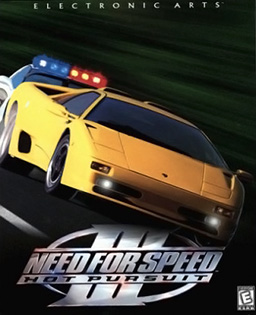
Need for Speed III: Hot Pursuit is a 1998 racing video game developed for PlayStation by EA Canada and Microsoft Windows by EA Seattle, and published by Electronic Arts. It is the third major installment in the Need for Speed franchise, incorporating police pursuits as a major part of gameplay. Hot Pursuit remains focused on racing using exotic sports cars, but features races that primarily take place in locations within North America, including varied settings and climates. Police AI is improved over the first game, utilizing several tactics to stop both the player and opponent. The PlayStation version was released on March 25, 1998, while the Windows version was released on October 12 the same year. The game received critical success, with praise for its graphics and customization options. It received a direct sequel in 2002 and a reboot in 2010.

Colin McRae Rally 2.0 is a racing video game developed and published by Codemasters for PlayStation, Microsoft Windows and Game Boy Advance.
Dirt Track Racing 2 (DTR2) is a video game developed by the now defunct Ratbag Games and published by Infogrames. It is the third and final game in the Dirt Track Racing series by Ratbag.
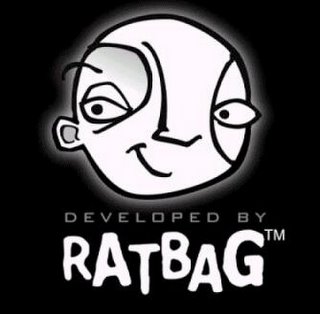
Ratbag Games Pty Ltd was an Australian developer of video games such as Powerslide, The Dukes of Hazzard: Return of the General Lee and World of Outlaws: Sprint Cars 2002.

World of Outlaws: Sprint Cars 2002, also known as simply World of Outlaws: Sprint Cars for the Microsoft Windows and PAL region PlayStation 2 versions, is a sprint car racing video game developed by the Australian developer Ratbag Games and published by Ignition Entertainment in the PAL region and Infogrames in North America for the PS2 and Windows. GameSpot's review of the former console version described that the "gameplay is solid and the physics are top-notch." The game had a limited sales run; it developed a large following and it was widely requested at video game stores.
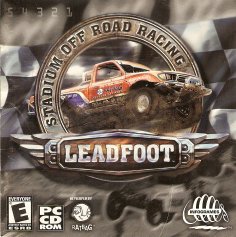
Leadfoot: Stadium Off-Road Racing, or Leadfoot for short, is a computer video game by the now defunct Ratbag Games. It is a spin-off of the dirt track racing series by Ratbag, which includes Dirt Track Racing, Dirt Track Racing: Sprint Cars and Dirt Track Racing 2. It is a racing game simulation reproducing the sport of stadium off-road racing. Pick-up trucks and buggies race around dirt tracks built inside stadiums - Supercross on four wheels.

Dirt Track Racing is a video game by the now defunct developer Ratbag Games. It is the first game in the series, which includes Dirt Track Racing, Dirt Track Racing: Sprint Cars, and Dirt Track Racing 2.
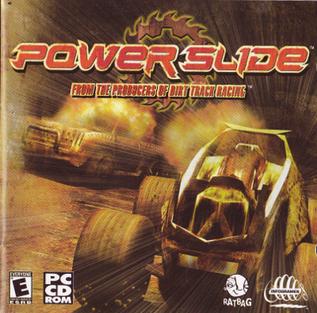
Powerslide is a post-apocalyptic Microsoft Windows racing game by Australian developer Ratbag Games. It was released in Australia, United States and Europe in 1998. Powerslide was praised for its graphics and AI in particular. A sequel, Powerslide: Slipstream, was in development as of 2004, but Ratbag couldn't find a suitable publisher, and shortly after the company was shut down. Powerslide was re-released on GOG.com in 2012.

Colin McRae: Dirt 2 is a racing video game developed and published by Codemasters in 2009, first for the Nintendo DS, PlayStation 3, PlayStation Portable, Wii and Xbox 360, and then later for PC platforms. It is the sequel to Colin McRae: Dirt. Dirt 2 is the first game in the series since McRae's death in 2007 and the last to feature his name in the title. It is also the first and only game in the series to be available on a Nintendo home console and the last game in the series to be released on handhelds.

Superbike 2001 is a motorcycle racing video game developed by Milestone srl, published by Electronic Arts (EA), and released in 2000 for Microsoft Windows. It is part of EA's Superbike video game series.

F1 2001 is a racing video game developed by Image Space Incorporated for the Microsoft Windows version and EA UK for the PlayStation 2 and Xbox version and published by EA Sports for Microsoft Windows, PlayStation 2 and Xbox. It is based on the 2001 Formula One season. A port for GameCube was planned, but cancelled for unknown reasons, and eventually released with minor changes as F1 2002. A Game Boy Color version was also cancelled during development.

TrackMania is a racing video game developed by Ubisoft Nadeo and published by Focus Home Interactive. It is the first game in the TrackMania series.



















